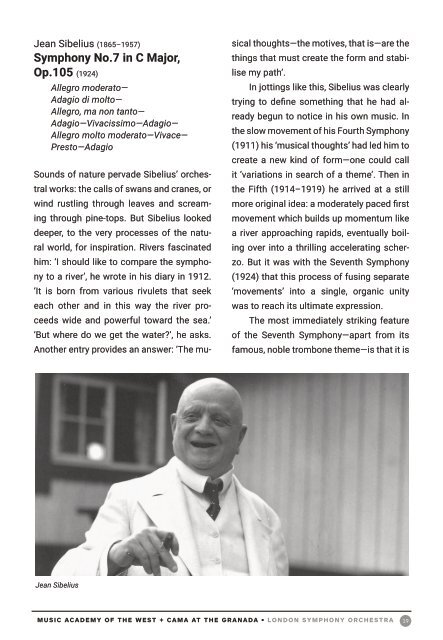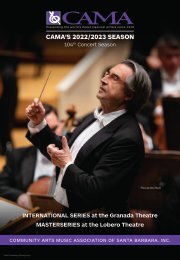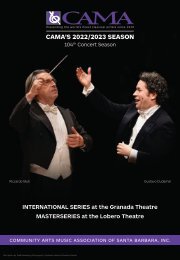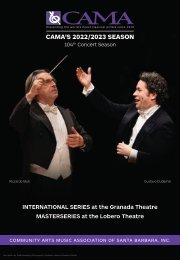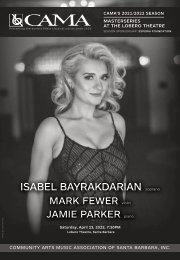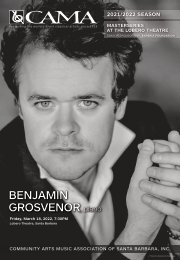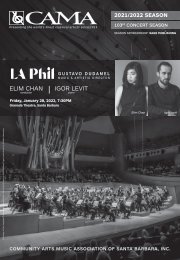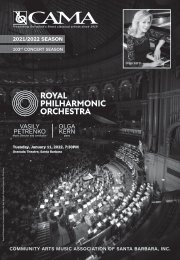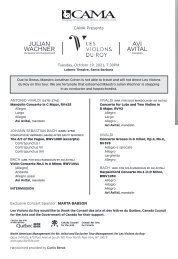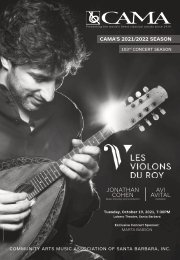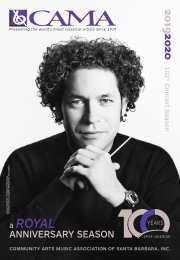Thursday, March 24, 2022 ⫽ Music Academy of the West and CAMA ⫽ LONDON SYMPHONY ORCHESTRA ⫽ International Series at the Granada Theatre ⫽ Santa Barbara, California
London Symphony Orchestra Sir Simon Rattle, Music Director Thursday, March 24, 2022 The Music Academy of the West and Community Arts Music Association of Santa Barbara, Inc. co-present the London Symphony Orchestra in concert in celebration of the Music Academy’s 75th anniversary “The importance of making concerts into events is something that Simon Rattle has brought back to the LSO.” —The Guardian Among the greatest of all orchestras today, the legendary London Symphony Orchestra will return to Santa Barbara in March 2022 for a special 5-day residency with the Music Academy of the West led by Sir Simon Rattle who is universally recognized as one of the world’s leading conductors, having served since the early 1980’s as Music Director of the City of Birmingham Symphony Orchestra, the Berlin Philharmonic and currently with the LSO. Join CAMA and the Music Academy of the West for this not-to-be-missed historic Santa Barbara classical music concert collaboration. PROGRAM: BERLIOZ: Le Corsaire (Ouverture), Op.21 HANNAH KENDALL: The Spark Catchers SIBELIUS: Symphony No.7 in C Major, Op.105 BARTÓK: The Miraculous Mandarin, Op.19, Sz.73 (BB 82) RAVEL: La Valse •
London Symphony Orchestra
Sir Simon Rattle, Music Director
Thursday, March 24, 2022
The Music Academy of the West and Community Arts Music Association of Santa Barbara, Inc. co-present the London Symphony Orchestra in concert in celebration of the Music Academy’s 75th anniversary
“The importance of making concerts into events is something that Simon Rattle has brought back to the LSO.” —The Guardian
Among the greatest of all orchestras today, the legendary London Symphony Orchestra will return to Santa Barbara in March 2022 for a special 5-day residency with the Music Academy of the West led by Sir Simon Rattle who is universally recognized as one of the world’s leading conductors, having served since the early 1980’s as Music Director of the City of Birmingham Symphony Orchestra, the Berlin Philharmonic and currently with the LSO.
Join CAMA and the Music Academy of the West for this not-to-be-missed historic Santa Barbara classical music concert collaboration.
PROGRAM:
BERLIOZ: Le Corsaire (Ouverture), Op.21
HANNAH KENDALL: The Spark Catchers
SIBELIUS: Symphony No.7 in C Major, Op.105
BARTÓK: The Miraculous Mandarin, Op.19, Sz.73 (BB 82)
RAVEL: La Valse
•
Create successful ePaper yourself
Turn your PDF publications into a flip-book with our unique Google optimized e-Paper software.
Jean Sibelius (1865–1957)<br />
Symphony No.7 in C Major,<br />
Op.105 (1924)<br />
Allegro moder<strong>at</strong>o—<br />
Adagio di molto—<br />
Allegro, ma non tanto—<br />
Adagio—Vivacissimo—Adagio—<br />
Allegro molto moder<strong>at</strong>o—Vivace—<br />
Presto—Adagio<br />
Sounds <strong>of</strong> n<strong>at</strong>ure pervade Sibelius’ orchestral<br />
works: <strong>the</strong> calls <strong>of</strong> swans <strong>and</strong> cranes, or<br />
wind rustling through leaves <strong>and</strong> screaming<br />
through pine-tops. But Sibelius looked<br />
deeper, to <strong>the</strong> very processes <strong>of</strong> <strong>the</strong> n<strong>at</strong>ural<br />
world, for inspir<strong>at</strong>ion. Rivers fascin<strong>at</strong>ed<br />
him: ‘I should like to compare <strong>the</strong> symphony<br />
to a river’, he wrote in his diary in 1912.<br />
‘It is born from various rivulets th<strong>at</strong> seek<br />
each o<strong>the</strong>r <strong>and</strong> in this way <strong>the</strong> river proceeds<br />
wide <strong>and</strong> powerful toward <strong>the</strong> sea.’<br />
‘But where do we get <strong>the</strong> w<strong>at</strong>er?’, he asks.<br />
Ano<strong>the</strong>r entry provides an answer: ‘The musical<br />
thoughts—<strong>the</strong> motives, th<strong>at</strong> is—are <strong>the</strong><br />
things th<strong>at</strong> must cre<strong>at</strong>e <strong>the</strong> form <strong>and</strong> stabilise<br />
my p<strong>at</strong>h’.<br />
In jottings like this, Sibelius was clearly<br />
trying to define something th<strong>at</strong> he had already<br />
begun to notice in his own music. In<br />
<strong>the</strong> slow movement <strong>of</strong> his Fourth Symphony<br />
(1911) his ‘musical thoughts’ had led him to<br />
cre<strong>at</strong>e a new kind <strong>of</strong> form—one could call<br />
it ‘vari<strong>at</strong>ions in search <strong>of</strong> a <strong>the</strong>me’. Then in<br />
<strong>the</strong> Fifth (1914–1919) he arrived <strong>at</strong> a still<br />
more original idea: a moder<strong>at</strong>ely paced first<br />
movement which builds up momentum like<br />
a river approaching rapids, eventually boiling<br />
over into a thrilling acceler<strong>at</strong>ing scherzo.<br />
But it was with <strong>the</strong> Seventh Symphony<br />
(1924) th<strong>at</strong> this process <strong>of</strong> fusing separ<strong>at</strong>e<br />
‘movements’ into a single, organic unity<br />
was to reach its ultim<strong>at</strong>e expression.<br />
The most immedi<strong>at</strong>ely striking fe<strong>at</strong>ure<br />
<strong>of</strong> <strong>the</strong> Seventh Symphony—apart from its<br />
famous, noble trombone <strong>the</strong>me—is th<strong>at</strong> it is<br />
Jean Sibelius<br />
MUSIC ACADEMY OF THE WEST + <strong>CAMA</strong> AT THE GRANADA • <strong>LONDON</strong> <strong>SYMPHONY</strong> <strong>ORCHESTRA</strong><br />
19


